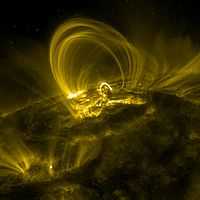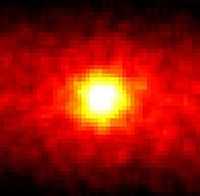Radiation astronomy/Empiricisms/Laboratory
< Radiation astronomy < Empiricisms
This laboratory is an activity for you to create an empiricism to explain an astronomical situation.
Some suggested empirical entities to consider are space, time, spectrum, electromagnetic radiation, neutrinos, mass, time, Euclidean space, Non-Euclidean space, and spacetime.
More importantly, there are your empirical entities.
| |
Educational level: this is a secondary education resource. |
You may choose to define your empirical entities or use those already discussed in lectures.
Usually, research follows someone else's ideas of how to do something. But, in this laboratory you can create these too.
Evaluation
|
Okay, this is an astronomy empiricism laboratory, but you may create what an astronomy, an empiricism, or a laboratory is.
Yes, this laboratory is structured.
I will provide one example of an empiricism. The rest is up to you.
Questions, if any, are best placed on the discussion page.
Control group
For creating an empiricism appropriate for your research effort of choice, what would make an acceptable control group?
Think about a control group to compare your empirical approach or your process of creating an empiricism to.
Empiricisms


Neutrinos are hard to detect. The Super-Kamiokande, or "Super-K" is a large-scale experiment constructed in an unused mine in Japan to detect and study neutrinos. The image at right required 500 days worth of data to produce the "neutrino image" of the Sun. The image is centered on the Sun's position. It covers a 90° x 90° octant of the sky (in right ascension and declination). The higher the brightness of the color, the larger is the neutrino flux.
Some experimental evidence indicates that reactions producing neutrinos are occurring above the photosphere of the Sun, or Sol.
The image at the right suggests that the neutrino data from Super-K contains orientation with some error, perhaps associated with right ascension and declination relative to that of the Sun when each neutrino was detected.
If the data in this image is properly centered on the Sun's position and in the plane of the ecliptic (laterally across the image), then the band-like structure of the data suggests a band-like origin for the neutrinos in the plane of the ecliptic.
The image in the above section is an octant (90° x 90°) of the celestial dome centered on the Sun's position. The image is approximately 50 mm x 50 mm and the central most intense region is about 6 mm in diameter. The hot central spot is about 10.8° in diameter. Depending on orbital distance of the detector from the Sun, the Sun's diameter is 31.6-32.7'. If the image is 90° on a side, then the actual disk of the Sun at 32' is 0.3 mm in diameter on the image. This is less than a pixel width at about 1 mm.
If the core of the Sun is 0.2 to 0.25 solar radii, it is only 0.2 to 0.25 of the diameter, or 0.075 mm on the image.
Two-four solar radii, or diameters, is a circle between 0.6 and 1.2 mm on the same image. Both the solar core and the coronal clouds are so small on this image, if it is over a solar octant, that it may not be statistically possible to differentiate the core from a shell around and over the Sun of 2-4 solar diameters.
One key piece of information is the apparent alignment of the detected neutrinos to the ecliptic which suggests that few if any neutrinos originate from the solar polar coronal holes, or the solar poles. Omnidirectional emission of neutrinos from the solar core should not produce this band-like appearance of the data.
The second figure at the right shows the data for a 94% correlation between neutrino detections and the solar cycle, with minima at the solar quiet periods. As nearly all sunspots are between high latitudes and the equator and not at the solar poles, this appears to correlate with the band-like accumulative signal.
Verification
The photosphere of the Sun has an angular size of 31.6-32.7'.
Report
Title
by line
Abstract
Introduction
Experiment
Results
Discussion
Conclusion
Evaluation
To assess your empiricism, including your justification, analysis and discussion, I will provide such an assessment of my examples for comparison.
Evaluation
See also
Research
Hypothesis:
- Each of the hypotheses entered under research is an empiricism.
Control groups

The findings demonstrate a statistically systematic change from the status quo or the control group.
“In the design of experiments, treatments [or special properties or characteristics] are applied to [or observed in] experimental units in the treatment group(s).[1] In comparative experiments, members of the complementary group, the control group, receive either no treatment or a standard treatment.[2]"[3]
Proof of concept
Def. a “short and/or incomplete realization of a certain method or idea to demonstrate its feasibility"[4] is called a proof of concept.
Def. evidence that demonstrates that a concept is possible is called proof of concept.
The proof-of-concept structure consists of
- background,
- procedures,
- findings, and
- interpretation.[5]
References
- ↑ Klaus Hinkelmann, Oscar Kempthorne (2008). Design and Analysis of Experiments, Volume I: Introduction to Experimental Design (2nd ed.). Wiley. ISBN 978-0-471-72756-9. http://books.google.com/?id=T3wWj2kVYZgC&printsec=frontcover.
- ↑ R. A. Bailey (2008). Design of comparative experiments. Cambridge University Press. ISBN 978-0-521-68357-9. http://www.cambridge.org/uk/catalogue/catalogue.asp?isbn=9780521683579.
- ↑ "Treatment and control groups, In: Wikipedia". San Francisco, California: Wikimedia Foundation, Inc. May 18, 2012. Retrieved 2012-05-31.
- ↑ "proof of concept, In: Wiktionary". San Francisco, California: Wikimedia Foundation, Inc. November 10, 2012. Retrieved 2013-01-13.
- ↑ Ginger Lehrman and Ian B Hogue, Sarah Palmer, Cheryl Jennings, Celsa A Spina, Ann Wiegand, Alan L Landay, Robert W Coombs, Douglas D Richman, John W Mellors, John M Coffin, Ronald J Bosch, David M Margolis (August 13, 2005). "Depletion of latent HIV-1 infection in vivo: a proof-of-concept study". Lancet 366 (9485): 549-55. doi:10.1016/S0140-6736(05)67098-5. http://www.ncbi.nlm.nih.gov/pmc/articles/PMC1894952/. Retrieved 2012-05-09.
External links
- African Journals Online
- Bing Advanced search
- Google Books
- Google scholar Advanced Scholar Search
- International Astronomical Union
- JSTOR
- Lycos search
- NASA/IPAC Extragalactic Database - NED
- NASA's National Space Science Data Center
- NCBI All Databases Search
- Office of Scientific & Technical Information
- PubChem Public Chemical Database
- Questia - The Online Library of Books and Journals
- SAGE journals online
- The SAO/NASA Astrophysics Data System
- Scirus for scientific information only advanced search
- SDSS Quick Look tool: SkyServer
- SIMBAD Astronomical Database
- SIMBAD Web interface, Harvard alternate
- Spacecraft Query at NASA.
- SpringerLink
- Taylor & Francis Online
- Universal coordinate converter
- Wiley Online Library Advanced Search
- Yahoo Advanced Web Search
![]() This is a research project at http://en.wikiversity.org
This is a research project at http://en.wikiversity.org
| |
Development status: this resource is experimental in nature. |
| |
Educational level: this is a research resource. |
| |
Subject classification: this is an astronomy resource. |